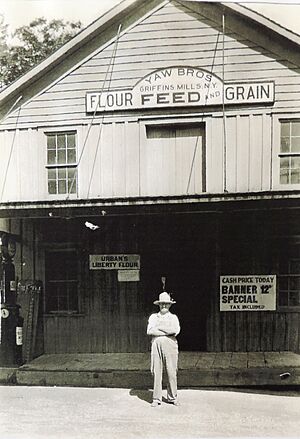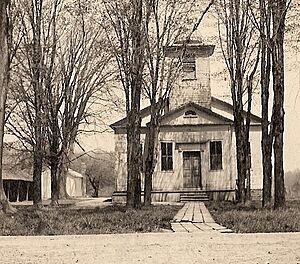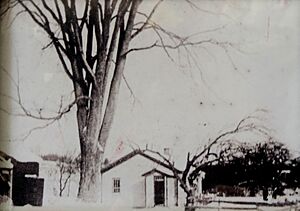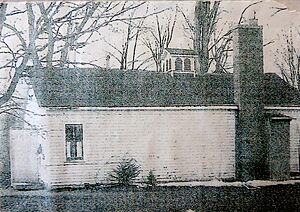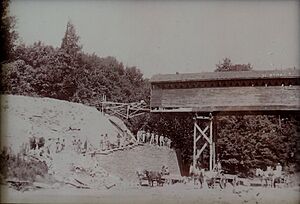Griffins Mills, New York facts for kids
Quick facts for kids
Griffins Mills
|
|
|---|---|
| Country | United States |
| State | New York |
| County | Erie County |
| Town | Aurora |
| Elevation | 932 ft (284 m) |
| Time zone | UTC-5 (Eastern (EST)) |
| • Summer (DST) | UTC-4 (EDT) |
| Area code | 716 |
| GNIS feature ID | 951821 |
Griffins Mills is a small community called a hamlet in Aurora, Erie County, New York. It is located along the West Branch of Cazenovia Creek. This area was once known as West Aurora. Griffins Mills started in the early 1800s around a busy mill. You can find it in zip code 14170.
Contents
Exploring Griffins Mills' Past
The Story of the Mills
Griffins Mills was first called Smith's Mills. In 1806, Abram Smith and his son Humphrey bought this land. They also bought two other spots along Cazenovia Creek. By 1809, Humphrey Smith had built a dam on the creek. He then opened a mill here.
Around the same time, a man named Obadiah Griffin lived in Canada. He and his family moved back to the United States during the War of 1812. They wanted to live near Obadiah's brother in Orchard Park.
When they returned to New York, Obadiah and his sons bought the mill. This is how the area got its name: Griffins Mills. They ran several successful businesses. These included a saw mill (for cutting wood) and a grist mill (for grinding grain). They also had a carding mill, a distillery, and asheries. Asheries made potash and lye for soap. Water from the creek powered all these operations.
Obadiah's wife passed away before 1822. In 1829, the mills were sold to Henry N. Hill. The Griffin family then moved west to Michigan. Over the years, the mills had many different owners. In 1884, Ferdinand Wanneke from Germany took over. He ran the business until 1903.
Ferdinand sold the mills to his nephews, Theodore and Frank Yaw. The Yaw Brothers were well-known in western New York. They ran the business for 56 years. They were famous for their accurate lumber cutting. They also specialized in grinding buckwheat flour. This was the only mill in a large area that did this. The flour was very popular. It was sold in special bags with the Yaw Brothers' trademark.
The grist and sawmills used water power for a long time. But in 1919, a big flood washed away the dam. After that, electric motors were installed. The original gristmill was very old, 137 years old, when it was destroyed by fire in 1947. The sawmill was changed into a feed mill. This business continued until 1959.
Theodore C. Yaw died in March 1959. Frank H. Yaw died in December 1960. In 1961, the mill building was given to St. Paul's Lutheran Church. It was moved and used as a Sunday school building.
Local Churches
The West Aurora Congregational Church started on August 18, 1810. It began with nine members. Reverend Elias Harmon was their first pastor. The church building was finished in 1832. In 1844, a large bronze bell was bought for the steeple. In 1848, land was bought to build a meeting room and horse shed. The church became the Griffins Mills Presbyterian Church in 1907. It is still active today.
St. Paul's Lutheran Church began in 1874. Services were held in people's homes at first. The church was officially formed in 1892. It is also still a very active church.
Other churches existed in the past. A Methodist Episcopal church started in 1850. A Baptist church was formed around 1868 but later closed. From 1893 to 1944, a Mennonite Meeting house was in the area.
Other Businesses in Griffins Mills
In 1813, Robert Griffin opened a tavern. This was a place where people could gather. The Griffin family's distillery made drinks from grains. By 1820, these drinks were common. A local store was opened by Adam Paul. He was in business for almost 30 years. The mail route came through Griffins Mills in 1814. Mail carriers would stop at Griffin's Tavern. The tavern was torn down in 1848.
There were also at least two tanneries in Griffins Mills. Tanneries process animal skins to make leather. They used hemlock bark in large vats to create a special acid. This acid helped remove hair from the skins. It also made the skins soft for leather. Tanneries often had a strong smell.
The first tannery was run by Ledyard Phelps in 1828. Another tannery was started in 1843 by Aaron Rumsey and his sons. These tanneries were important. Farmers in the area raised many cattle and pigs. Leather was used to make shoes, boots, and harnesses. A lot of leather was also sent to other markets. The Rumsey family processed over 300,000 animal hides each year.
The Old Schoolhouse
There was a schoolhouse, School #5, behind the West Aurora Congregational Church. It was built in the 1820s. Children went to this school until 1964. Then, students moved to the new West Falls Elementary School. This new school combined several smaller schoolhouses. The old schoolhouse was sold to the church in 1965. It was torn down in 1966.
Griffins Mills Cemetery
The West Aurora Cemetery Society was formed in 1834. The land for the cemetery was a gift from Colonel Orange Train Brown. It was an old peach orchard. Before this cemetery, many people were buried in the West Aurora Graveyard Cemetery. Their bodies were later moved to the new site.
Many important people are buried here. This includes five soldiers from the Revolutionary War. There are also veterans from the War of 1812 and the Civil War. The names of most people buried here are recorded by the Aurora Historical Society.
The Underground Railroad Connection
People in the Griffins Mills area strongly opposed slavery. The West Aurora Congregational Church passed anti-slavery resolutions in 1846.
There are no written records of how many people passed through the village to freedom. However, local stories suggest that Cazenovia Creek helped provide a hidden path to Buffalo. Some people say there was a tunnel from a house to the creek near the mill. This tunnel was filled in during road work in the 1970s. There is also evidence of a "secret room" in a local home.
Bridges Over Cazenovia Creek
Before 1867, travelers coming from East Aurora had to cross Cazenovia Creek by wading through it. This was a difficult crossing.
To make travel easier, a covered wooden bridge was built. This bridge allowed people to cross the creek without wading. In 1924, the wooden bridge was replaced by a strong steel bridge.
Places to Visit Nearby
- Mill Road Scenic Overlook
- Hawk Creek Wildlife Center, Inc.
- Western New York Scenic Byway
- East Aurora
Famous People From Griffins Mills
- Obadiah Griffin
- Adam Paul
- Isaac Phelps, Jr.
- Clement King
- William Conklin





